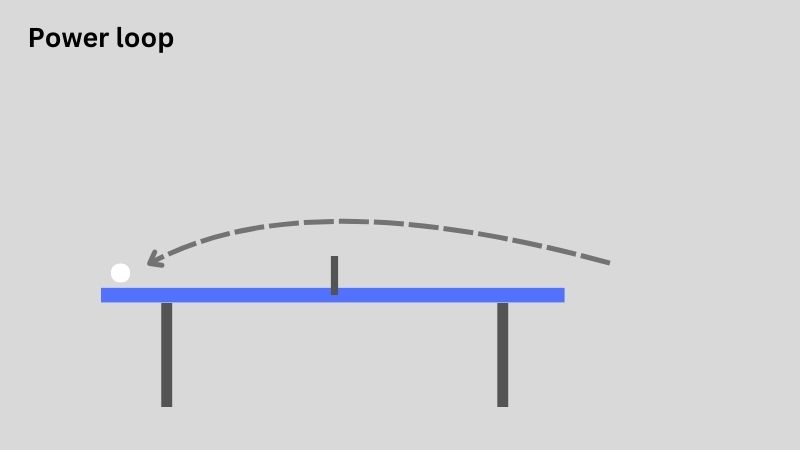Sometimes you hear people call an attacking shot a ‘topspin’. Other times you hear people call an attacking shot a ‘loop’. Are they different? If so, how?
Essentially we are talking about this same thing. Almost all attacking shots will have an element of topspin. Some will have lots of topspin, others will have just a little.
Traditionally, a ‘loop’ refers to a topspin attack with a higher arc over the net. A player will brush the ball very finely, with lots of acceleration with a more vertical swing. This makes the ball lift up over the net and the spin drags the ball back down on the other side of the table. The ball is making looping type motion – hence where the name of loop comes from. This looping type of topspin could be played against both a backspin ball (closer to the table) or a topspin ball (further away from the table).

Perhaps this looping motion was more pronounced with the smaller 38mm balls in the 70s, 80s, 90s. Back then the game was even more spin oriented. Players were happier to play a little further back and the forehand was the dominant stroke. This meant there were lots of looping rallies – forehand to forehand – with big arcs and huge spin.
Today, these rallies still happen. Players still use traditional loops. But the modern game – at pro level at least – is even faster and more direct with players trying to dominate closer to the table. It is common to hear these direct topspin attacks called a “kill loop” or a “power loop”. How are these different to a traditional loop?
A ‘power loop’ still has a lot of topspin, but the swing is much more forwards and the ball has a much more linear arc over the net. The benefit of a power loop is that it can be played closer to the table, still with huge spin, but a lot more speed compared to a traditional loop. However, it has a smaller margin for error, and requires a high level of skill to do consistently.

What about a ‘loop drive’? Is this even a thing? Well yes, I suppose it is. It’s more likely to be called a ‘topspin drive’, but it basically means an attacking shot with some topspin, but plenty of ‘hit’ too. The contact is much thicker. This is also a direct attack, played closer to the table, but the aim is to get more speed than spin. This type of attack won’t have much arc at all. There will be a little lift up and down, but it’s much straighter compared to a traditional loop. Whilst a topspin-drive will be used at the pro level, it is also a very common way of attacking at the amateur level.

To summarise, all ‘loops’ are types of topspin attacks. If we want to be accurate, we can say that a traditional ‘loop’ is a type of topspin attack with a higher arc over the net. A ‘power loop’ is a type of topspin attack, but with a lower arc over the net. A ‘loop-drive’ is half topspin, half hit, with a more direct arc over the net.
Confused? Hopefully not. You don’t need to get too bogged down in the terminology. You say loop. I say topspin. It really doesn’t matter. We’re referring to the same sort of thing. All that matters is that you are spinning the ball over the net and beating your opponent!
Need technique advice?
If you need help with your game, I recommend you join Tom’s TT Academy. You can submit video footage for analysis and get help from me in my coaching clinic. You will also get access to a wide range of coaching content, including
- in-depth courses
- training drills
- fitness videos
- robot training videos
- member discussions
- skill challenges
- and lot’s more!
You can access all this content for less than £1 per week. New content is added regularly. Join hundreds of table tennis players around the world today at tomsttacademy.com
